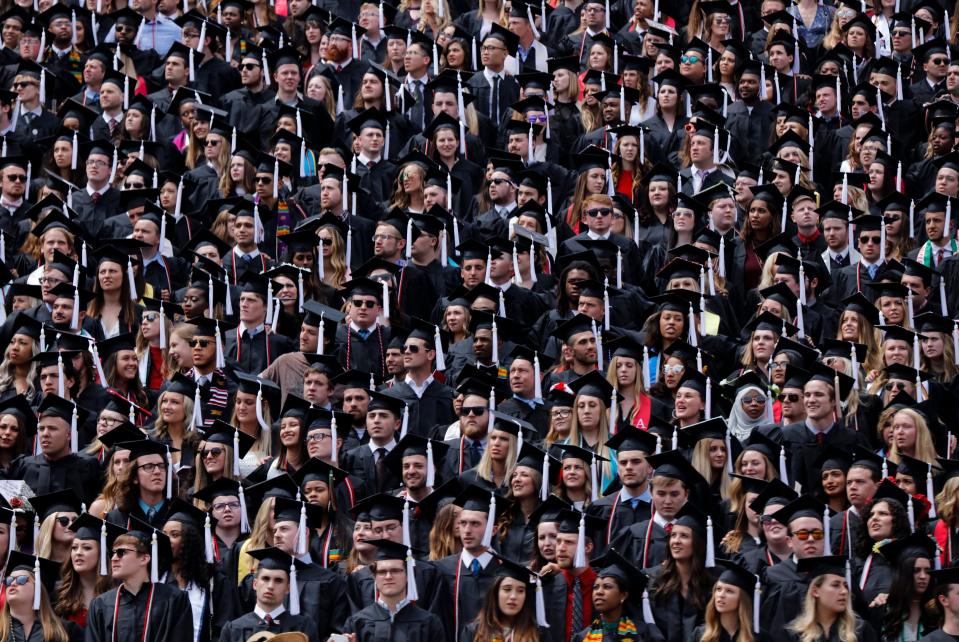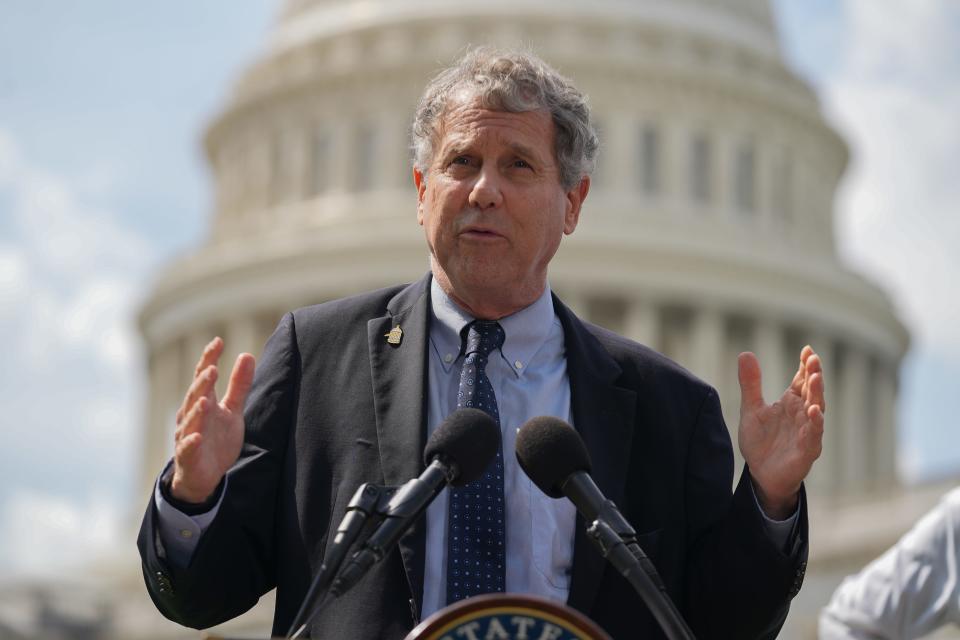As central Ohio’s tech industry grows, high-skilled immigrants may be needed to fill jobs

- Oops!Something went wrong.Please try again later.
Gov. Mike DeWine has taken to calling Ohio the “Silicon Heartland.”
Technology firms have proliferated in Greater Columbus in recent decades. In early 2022, Intel announced it would invest $20 billion in Licking County for two new semiconductor factories. It has applied for funding from the CHIPS & Science Act, part of the Biden Administration’s effort to build more of the tiny, ubiquitous devices domestically. In June this year, Amazon announced a $7.8 million investment in data centers in central Ohio.
As central Ohio gears up to become a technology hub, industry leaders have signaled a need for more highly skilled foreign workers to meet growing labor demand that they say cannot be met by Americans alone. The burgeoning tech industries have renewed discussion of the country’s H-1B program, which is the primary pathway for admitting highly skilled, non-immigrant workers to the U.S.
A July report by The Semiconductor Industry of America projected that the industry’s workforce will grow from approximately 345,000 jobs today to 460,000 by 2030, and that 67,000 jobs — or 58% — risk going unfilled at current degree completion rates.
“Simply put, the workforce gap for individuals with advanced engineering and computer science degrees cannot be realistically addressed for the foreseeable future solely with U.S.-citizen graduates,” it said.
Similarly, a recent Brookings Institution report argued that increasing H-1B issuances from the current annual cap of 85,000 could help meet growing industry demand.
But the H-1B visa program also faces criticism from a variety of quarters. Some argue that it is overused in the tech industry and is sometimes used to replace American workers. Others argue that the system is unfair to foreign workers by tying their immigration status to their employment, which makes it difficult for them to negotiate for higher wages or change jobs.

Ohio’s Republican Senator J.D. Vance campaigned against the H-1B program in his 2022 race, calling it “an unholy alliance between government and our biggest corporations” that allows companies “to undercut the wages of American workers.”
Vance’s office did not respond to questions from The Dispatch for this article.
Democratic Sen. Sherrod Brown has also voiced concerns about abuses of the H-1B system, and is co-sponsoring a bill aimed at reining in fraud.
A spokesperson for Brown told The Dispatch that the senator has supported a variety of jobs-skill training programs to support the Intel project in central Ohio.
“(Brown) also believes that we need to fix our broken immigration system — by securing our southern border and passing comprehensive immigration reform that reforms the visa system in a way that meets the need of both Ohio workers and Ohio manufacturers and businesses,” they said.
The H-1B system, labor supply and demand
The H-1B is a temporary, non-immigrant visa category that was created in 1990; it is available for “specialty occupations” that generally require at least a bachelor’s degree. Employers apply for the visas on behalf of their workers and must attest they will pay the foreigner the equivalent wage of an American worker.
The annual cap on H-1B visas has been set at 65,000, plus 20,000 for master’s and doctorate graduates of American universities — numbers that have not been revised in decades.
Because there are almost always more applicants than available visas, a lottery is used to distribute them. The lottery is based on chance, not necessarily who has the highest level of education or the highest salary among the applicant pool.
Once issued, H-1Bs are generally valid for three years and can be extended up to six, or indefinitely if the worker also applies for permanent residency. Obtaining a green card can take many decades for U.S.-based Indian and Chinese workers, however, because of country-based annual application ceilings.
Mark Partridge, a professor and urban economist at Ohio State University, told The Dispatch that H-1B holders and other foreign workers are necessary because not enough Ohioans are earning computer science and engineering degrees — especially at the master’s and doctoral level — to meet industry demand.
Nationwide, half of all engineering master’s graduates and over 60% of PhD graduates are foreign citizens, according to the semiconductor industry report. At Ohio State, 66% of engineering PhDs and 37% of master’s degrees awarded in the 2022-2023 school year went to international students.

“If central Ohio is to undergo such a transformation (into a technology hub), immigrants necessarily would have to play an important role,” Partridge said.
But Ronil Hira, a political science professor at Howard University, said that the labor gap described by the semiconductor industry is exaggerated. As evidence, he pointed to data from the U.S. Bureau of Labor Statistics projecting smaller job growth than the semiconductor industry’s predictions.
More generally, Hira says the tech industry is not currently facing a labor shortage, citing the hundreds of thousands of layoffs in the past two years.
“If employers are really complaining about shortages, we should be seeing wages going through the roof … (but) there's just no indication of that happening,” he added.
Changing the system
Even many supporters of the H-1B program acknowledge that there are problems with the system.
One of the most dramatic changes over the past decade or so has been the rising use of H-1Bs by consulting companies. Today, some of the top visa-getters are major consulting firms like Cognizant Technology Solutions, HLC America and Tata Consultancy Services, according to U.S. Citizenship and Immigration Services. Rather than develop products themselves, they primarily provide temporary labor to major American tech companies.
Giovanni Peri, an economics professor at the University of California at Davis, said that immigrants have been essential to innovation in places like Silicon Valley. He thinks that more H-1Bs are necessary to meet tech labor demand, but he also said consulting companies’ use of the visas is problematic.
These firms “are almost specialized in the business of getting these H-1B visas, and then subcontracting people who can do a quick job for big companies in times of need,” Peri said.
Although employers must attest that their use of foreign workers will not “adversely affect” their American employees, consulting companies have been able to skirt this stipulation.
In one of the most notorious cases, Disney laid off hundreds of tech workers in Florida, then had them train their replacements, who were mostly foreign workers from HCL and Cognizant on H-1Bs. After laid-off American workers sued, a judge ruled in favor of the consulting companies, whose lawyers argued the law did not apply to them because their foreign workers displaced American workers at another firm — not their own.
Dan Kotchen, a Washington, D.C.-based attorney who has represented American workers in similar cases, said that companies maintain extraordinary control over H-1B holders, who can face deportation if they lose their jobs.
“Companies use this threat of deportation to instill fear into foreign employees and subject the employees to horrific working conditions,” Kotchen said, likening it to “indentured servitude.”
Julia Gelatt, an associate director at the Washington, D.C.-based Migration Policy Institute, acknowledged that abuse of the system can hurt both American and foreign workers. But she said it’s necessary to reform the application process and also make it easier for talented H-1B workers to get the security afforded by a green card.
“We're shooting ourselves in the foot in the United States to make it so difficult for employers to attract talented foreign workers, and for talented foreign workers to stay in the United States long term,” she said.
Britta Glennon, a professor of management at the University of Pennsylvania’s Wharton School, said prioritizing H-1Bs based on factors like skills, education and salary level − and pegging the visa cap to the country's economic performance − could improve the system.
As president, Donald Trump spoke out against the use of H-1Bs, and under his direction U.S. Customs and Immigration Services increased visa denial rates dramatically.
Senator Vance also called out H-1B visas on the campaign trail, while investing in multiple companies that use them, according to Axios reporting. (He has defended this by saying he does not control the companies’ actions and never encouraged them to use the visas.)

The H-1B and L-1 Visa Reform Act currently in the Senate is sponsored by Sen. Dick Durbin (D-Ill.) and Chuck Grassley (R-Iowa), and co-sponsored by Sen. Brown and others. Among other things, it would force firms to be more transparent about their use of H-1Bs, increase the cost of applying, prioritize H-1B issuance for science and technology workers and increase penalties for employers who commit fraud.
Despite versions of the bill being introduced multiple times since 2007, it has never passed.
More: Some central Ohio tech workers waiting a lifetime for a green card
Peter Gill covers immigration, New American communities and religion for the Dispatch in partnership with Report for America. You can support work like his with a tax-deductible donation to Report for America at:bit.ly/3fNsGaZ.
pgill@dispatch.com
This article originally appeared on The Columbus Dispatch: As central Ohio tech industry grows so does,debate over visa program

